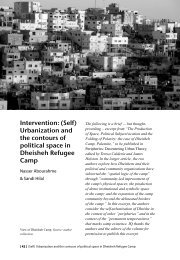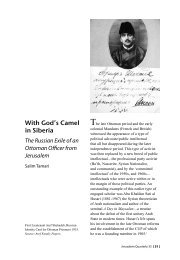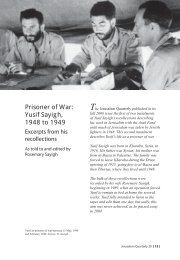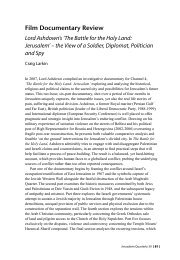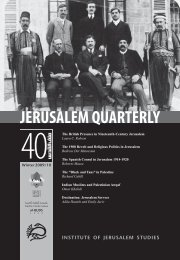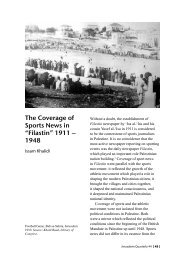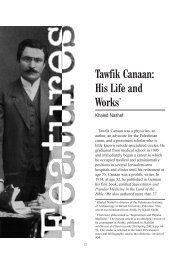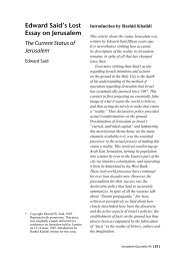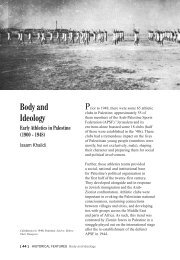Jurji Habib Hanania - Institute for Palestine Studies
Jurji Habib Hanania - Institute for Palestine Studies
Jurji Habib Hanania - Institute for Palestine Studies
Create successful ePaper yourself
Turn your PDF publications into a flip-book with our unique Google optimized e-Paper software.
the newspaper regularly without having to pay <strong>for</strong> it. For another, many of those who<br />
subscribed found themselves increasingly surrounded by friends who borrowed the<br />
paper on a regular basis and thus avoided becoming subscribers themselves! As a<br />
result, fewer copies of the paper were printed and distributed in its fifth year than in<br />
any of the previous four, according to its publisher. Even so, publication continued<br />
well into the sixth year, 1914. I have no record of when the last issue of al-Quds<br />
appeared but it is known that, at the start of the war, <strong>Jurji</strong> <strong>Hanania</strong> left Jerusalem and<br />
went to Alexandria, Egypt, where he died in 1920.<br />
A Selection of Items from al-Quds in its First Year (1908-9)<br />
The paper appeared in four pages. Columns, lines, squiggles or little patterns separated<br />
the different items, and there was an occasional design accompanying commercial ads,<br />
but there were no photographs. The flowery style, and the excessive use of honorific<br />
titles, were probably dictated by the customs of the day–and well-served by the<br />
richness of the Arabic language.<br />
The dates of the newspaper are at first confusing. Instead of one date, each issue of the<br />
paper carried three dates: the date according to the Julian calendar 1 (used throughout<br />
the Ottoman Empire and Russia), followed by the date according to the Gregorian<br />
calendar (used in most other countries), and followed by the Islamic date. All dates<br />
quoted in the selections below are Gregorian.<br />
Al-Quds on Ottoman Affairs<br />
The paper gave prominence to news about the Ottoman Empire and its rulers,<br />
particularly in the wake of the recently-introduced re<strong>for</strong>ms.<br />
• (18 Sept., 1908) The restoration of the constitution was an occasion <strong>for</strong> widespread<br />
celebration. (25 Sept., 1908) More celebration took place on the arrival in<br />
Jerusalem of the new governor, Subhi Beyk, who was met by cheering crowds<br />
and a lavish ceremony. Speeches and poems written to mark the occasion are<br />
reproduced in the newspaper.<br />
• (29 Sept., 1908) The lead article announces the <strong>for</strong>mation of a new society, the<br />
Arab-Ottoman Brotherhood, and goes on to argue <strong>for</strong> the utility of societies in<br />
“roaming around the government”, which is unable “by itself” to “mend the breaks<br />
and dress the wounds.”<br />
• (11 Oct., 1908) Five-hundred Ottoman fez (tarboush) are offered <strong>for</strong> sale to local<br />
citizens at the Jerusalem branch of the Committee <strong>for</strong> Union and Progress. The<br />
shipment had been requested from the committee’s leaders in Istanbul.<br />
[ 64 ] HISTORICAL FEATURES History of the Earliest Press in <strong>Palestine</strong>, 1908-1914



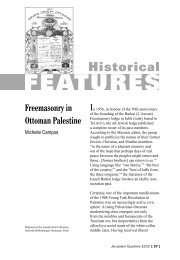
![In Search of Jerusalem Airport [pdf] - Jerusalem Quarterly](https://img.yumpu.com/49007736/1/180x260/in-search-of-jerusalem-airport-pdf-jerusalem-quarterly.jpg?quality=85)
